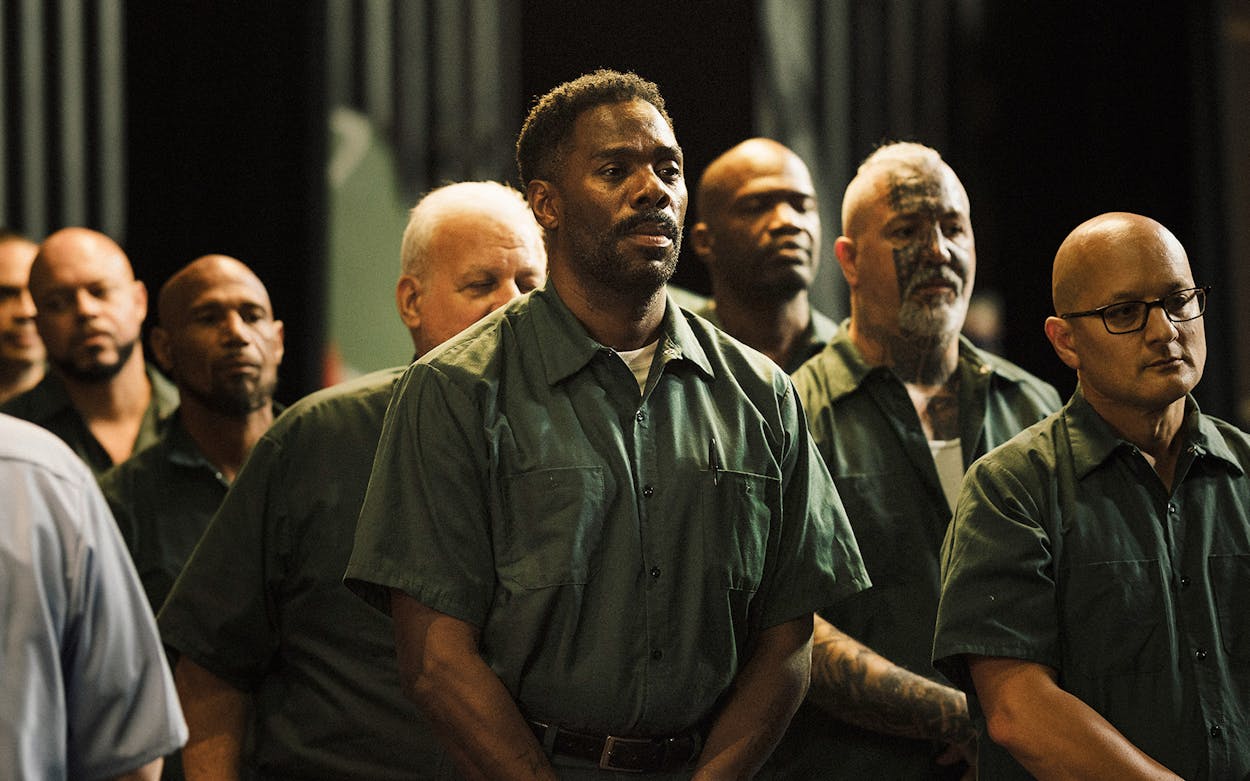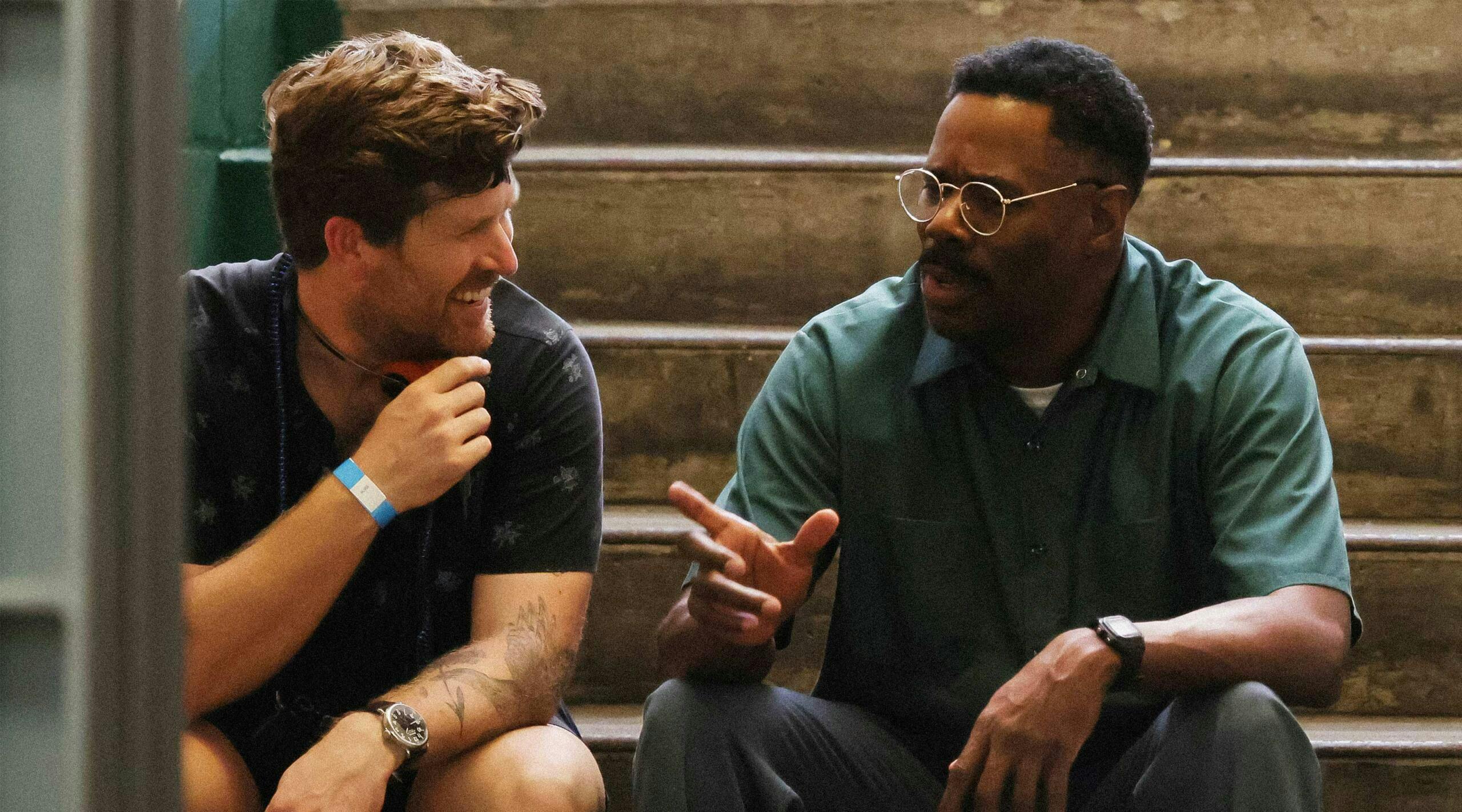‘Sing Sing’ Director Greg Kwedar on Making Art in Prison and Waves in Hollywood
The Austin-based filmmaker discusses his Colman Domingo–led movie’s long road to the red carpet.




Dominic Leon/A24
Greg Kwedar never expected any of this. He never expected that his movie Sing Sing, which is back in theaters this weekend after a brief release last summer, would be generating awards-season buzz. His last film, 2016’s Transpecos, was a taut, tense border thriller that received positive reviews but failed to find a theatrical audience. He spent the years that followed producing similarly well-regarded indies and learning about a prison-theater organization called Rehabilitation Through the Arts, which went on to serve as the basis for Sing Sing.
The film was acquired by the extremely hip indie distributor A24—the company behind Everything Everywhere All At Once, Lady Bird, Moonlight, and other movies that became the toasts of awards seasons—and stars veteran actor Colman Domingo, whose late-career renaissance in The Color Purple and Rustin makes him a compelling foil to a cast that largely consists of alumni of the very program the film is about. (As part of Sing Sing’s unusual funding model, all cast and crew members hold ownership stakes in the film.) So what’s it like to be a Texas filmmaker firmly entrenched in the indie world who suddenly finds himself with a movie widely regarded as one of the year’s best? We caught up with Kwedar to learn about awards season, prison theater, and what changes—and what doesn’t—when you get this kind of attention.
This interview has been edited for clarity and length.
Texas Monthly: You’re a Texas-based filmmaker whose movie is currently on the Hollywood awards circuit. How much time do you spend at home, rather than working out of Los Angeles or New York?
Greg Kwedar: I’m mostly based here in Austin, but this awards-season circuit is unrelenting. I was on a travel run that had started January second in Palm Springs, and then Palm Springs to L.A., and then L.A. to New York. I was supposed to go from New York back to L.A., but then that obviously all got put on hold [because of the wildfires].
TM: Obviously, there are greater tragedies out there, but is it sad to lose those opportunities?
GK: In some ways, yes. Some events are very warm and communal celebrations of movies and the people who make them, and we were going to be there in that room. But also, at the same time, it’s clear how immediately, none of it matters when something like this happens. You’re just like, “Why would you have a moment like that when many of the colleagues who are in that room are on the run because their homes might be burning?”



TM: Your previous film, Transpecos, premiered at South by Southwest in 2016. What was the process for getting this movie together, years later?
GK: I’ve been working on this project for over eight and a half years now, and it’s been such a meaningful, transformative, artistic journey for me—both how we came across the story and the way we developed it, which was in concert with the community of artists, many who are actual alumni of this theater program, who are our partners in making this movie. You hear this cliché all the time that art saves lives, but now I’ve seen it firsthand. It’s something people roll their eyes at, and we can sometimes, in our industry, get a little too self-serious about the impact of our work. But, you know, art really does save lives. I’ve come to believe that wherever people have access to art, they will thrive as humans. It takes you forward. It builds us. When you take it away, it sends us backwards. It happened inside Sing Sing Correctional Facility, which is one of the most dangerous places in the world. And that it happened there proves that it can happen anywhere.
TM: Are arts and theater particularly well suited to helping people who are incarcerated?
GK: You see it in the statistics, in the recidivism rates in our country. The likelihood of somebody returning to prison within five years of their release is over sixty percent across our country, which is astounding. But equally astounding is that less than three percent of participants of RTA—Rehabilitation Through the Arts—ever go back to prison. It’s not rocket science. Give access to opportunities like this, and people thrive.
There are always soft skills that come from accountability and being responsible for something, whether that’s learning lines or devising a start-up and having a partner, where you’re needing to do your half of the project. And then there are these deeper emotional things, particularly with theater, where you’re stepping outside of your shoes and into the shoes of another character, and seeing through someone else’s eyes. That is the act of empathy, when you understand their point of view and perspective. That is a kind of bridge that a lot of incarcerated people have not been able to build, and that’s the first step of repair—having empathy for who was harmed.
TM: How did you go from spending years getting to know the program to making a movie with Colman Domingo?
GK: We worked closely with the alumni of the program over six years of development. When we finally cracked the code on the story, it [emerged as] a story about a real-life friendship between these two men who couldn’t have been more different from each other. We invited these two men into the storytelling process with us, and I finally had this kind of lightning bolt of “Okay, this is how we do it,” and a treatment spilled out of me in about ten minutes onto a page. And at the bottom of the page, I just wrote “Colman Domingo.” I had an intuition. That was in the fall of 2021.
In February of 2022, we were able to get on a Zoom with him. We didn’t have a script to send him, because we were starting completely over. We had no budget. We just had this Esquire magazine article based on this program. But he got on Zoom with me and my creative partner, Clint Bentley. And at the end of this conversation, as we were telling the story of what we were hoping to make and all the years of development, he says, “You know, at this point in my career, I’m realizing that there are some projects that are seeking you to teach you something. You don’t know what it is; you just know it’s trying to. I’m saying yes to that at this point in my life, and I’ve got three weeks open this July.” And I was just like, “I’ll take them.” You know, even without scripts, money, or anything, I just had this confidence that if he was willing to lean in like that and go for it, we could too, and it would happen. I think he also really appreciated the invitation to create alongside us—that it wasn’t so baked that he couldn’t come in and bring the fullness of who he is as a playwright and as a writer and a director and an actor and really shape the film alongside us. We went through that process together. And by July, we were rolling with cameras, and we shot in those eighteen days that he had available. He finished The Color Purple and flew directly to us, started work the next day on Sing Sing, and then the day he wrapped, he was doing pickups for Rustin. We had not one day to spare.
TM: Sing Sing has had an interesting release, where it was in theaters over the summer and then sort of sat on a shelf, where it didn’t get released on streaming, and now it’s back in more theaters than ever. I can’t think of another movie that’s had a release like it.
GK: I don’t know that there is. It’s very much experimental, from A24’s standpoint. We had our theatrical release over the summer, where our heartfelt drama opened up against Deadpool and Wolverine and Twisters. Our partners decided, “Let’s revisit this process and relaunch it in 2025, hopefully with the support of awards season to get people to pay attention.” Once people see it, it connects in a way unlike anything I’ve ever been a part of. So the challenge is how to get people to see this film.
TM: Do you think the theatrical release is going to work this time?
GK: There’s a perception that this film is going to be, like, a “take your medicine and eat your vegetables” kind of story. But in reality, it’s funny. It makes you feel all the feels, and you leave so inspired. Not only for what’s possible in terms of how prisons can be different, and that there’s a better way, but around what you believe about humanity writ large. You see what’s possible through friendship and through choosing optimism over misery, and I think there’s something intensely relatable about it.
TM: Colman Domingo is on Oscars short lists now. He was nominated for a Golden Globe. Is there a point in the filmmaking process when you’re like, “I think I’m making an awards movie,” or does that come way later?
GK: We never, throughout the entire filmmaking process, thought we’d be in a moment like this. I will say, though, there were moments all along the journey of making this film where you have this realization—you almost don’t want to say it—that you’re making something special. You’re worried you’ll jinx it or or kill whatever that magic is if you say it too loud. But the first time we really started to accept that this might be part of our trajectory was when we premiered the film in Toronto in a theater with twelve hundred people. Most of our cast were in the room that night, and the way that that audience expressed their love for our cast, particularly our alumni, was one of the most transcendent experiences I’ve ever had inside of a theater. We walked out in a daze, feeling like, “Who knows where this thing is going, but it’s going somewhere.”
TM: Does having a movie that’s getting this reception pave the way for the next one?
GK: There are times, starting with the theatrical release, where you’re like, “Okay, so this is when all the offers come in, right? The phone is going to start ringing!” And, no, I didn’t get overwhelmed with offers. That did not happen. But I got one phone call that really did matter—the one that said there’d be funding for the next film—and that was all I needed. But there is one thing that is happening with this project in particular—it’s the way that it has connected with other actors, and what they feel about their own work, and about how they see how much we love actors in how we made this movie. That has been one of the big gifts of this. The opportunities with our next films, as we put them together—the quality of actors that respect this work is kind of breathtaking. I’m really encouraged and inspired by what we might be able to do going forward.
TM: It’s a year-and-a-half promotional cycle for this. Does that free you up creatively once the Oscars pass and this one’s fully behind you?
GK: This film in particular, because everyone who worked on it owns a part of it, is our film in a way that I think really means something. So this has been a true shared ride. I’m so glad we’ve gotten to celebrate this together, because promoting this movie has been one of the most exhausting things I’ve ever done—the amount of travel, all the time away from family. You’re not prepared for it, and it takes its pound of flesh from you. But at the same time, because of who I’m doing it with and because of what happens in the rooms when we show the movie and when audiences get to meet this cast and crew alongside Colman Domingo, who uses every moment to share the stage and shine light on all of us, you are restored from whatever it’s taken from you. You’re given something more back. And so I think where I’m at, at this point in the journey that began in September of 2023 and is still going, I almost don’t want it to be over, because I don’t want to say goodbye to what we’re all sharing together.
This post was originally published on this site be sure to check out more of their content.








